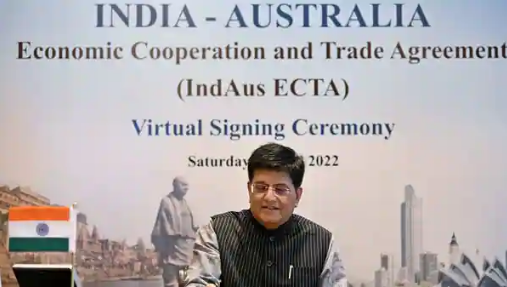India-Australia Economic Cooperation and Trade Agreement
- 06 Apr 2022
On 2nd April, 2022, India and Australia signed the India-Australia Economic Cooperation and Trade Agreement (ECTA). The negotiations for India-Australia ECTA were formally re-launched on 30 September 2021 and concluded on a fast-track basis by the end of March 2022.

(Image Source: Livemint)
India-Australia ECTA: Salient Features
Areas of Cooperation
- The Agreement encompasses cooperation across the entire gamut of bilateral economic and commercial relations between the two friendly countries, and covers areas like Trade in Goods, Rules of Origin, Trade in Services, Technical Barriers to Trade (TBT), Sanitary and Phytosanitary (SPS) measures, Dispute Settlement, Movement of Natural Persons,s Telecom, Customs Procedures, Pharmaceutical Products, etc.
- Eight subject specific side letters covering various aspects of bilateral economic cooperation were also concluded as part of the Agreement.
Benefits
- Boost to Bilateral Trade: The India-Australia ECTA will further cement the already deep, close and strategic relations between the two countries and will significantly enhance bilateral trade in goods and services, create new employment opportunities, raise living standards, and improve the general welfare of the peoples of the two countries.
- The ECTA is expected to increase trade between the two sides to $45-50 billion over five years, from the current estimate of $27 billion, and create over 10 lakh additional job opportunities.
- Institutional Mechanism: ECTA provides for an institutional mechanism to encourage and improve trade between the two countries.
- Preferential Market Access: The ECTA between India and Australia covers almost all the tariff lines dealt in by India and Australia respectively.
- India will benefit from preferential market access provided by Australia on 100% of its tariff lines. This includes all the labour-intensive sectors of export interest to India such as gems and jewellery, textiles, leather, footwear, furniture, food, and agricultural products, engineering products, medical devices, and automobiles.
- On the other hand, India will be offering preferential access to Australia on over 70% of its tariff lines, including lines of export interest to Australia which are primarily raw materials and intermediaries such as coal, mineral ores and wines, etc.
- Trade in Services: As regards trade in services, Australia has offered wide ranging commitments in around 135 sub sectors and Most Favoured Nation (MFN) in 120 sub sectors which cover key areas of India’s interest like IT, ITES, Business services, Health, Education, and Audio visual.
- On the other hand, India has offered market access to Australia in around 103 sub-sectors and Most Favoured Nation in 31 sub-sectors from the 11 broad service sectors such as ‘business services’, ‘communication services’, ‘construction and related engineering services’, and so on.
- Annex on Pharmaceutical Products: Both sides have also agreed to a separate Annex on Pharmaceutical products under this agreement, which will enable fast track approval for patented, generic and biosimilar medicines.
India-Australia Bilateral Trade
- India-Australia bilateral trade for both merchandise and services is valued at US$ 27.5 billion in 2021. India’s merchandise exports to Australia grew 135% between 2019 and 2021.
- India’s exports consist primarily of a broad-based basket largely of finished products and were US$ 6.9 billion in 2021.
- India’s merchandise imports from Australia were US$ 15.1 billion in 2021, consisting largely of raw materials, minerals and intermediate goods.
- Australia is the 17th largest trading partner of India and India is Australia’s 9th largest trading partner.
Significance of India-Australia Bilateral Economic and Trade Relations
- India and Australia have been each other’s important trading partners. These excellent bilateral economic and commercial relations have continued to enhance and deepen over time.
- Growing India-Australia economic and commercial relations contribute to the stability and strength of a rapidly diversifying and deepening bilateral relationship between the two countries.
Conclusion
- The India-Australia Comprehensive Strategic Partnership initiated during the India-Australia Leaders’ Virtual Summit held on 04 June 2020 is the cornerstone of our multi-faceted bilateral relations.
- India and Australia are partners in the trilateral Supply Chain Resilience Initiative (SCRI) arrangement along with Japan which seeks to enhance the resilience of supply chains in the Indo-Pacific Region.
- India and Australia are also members of the recently formed Quad, also comprising US, and Japan, to further enhance cooperation and develop partnership across several issues of common concerns.
- Both countries enjoy a special partnership characterized by shared values of pluralistic, parliamentary democracies, Commonwealth traditions, expanding economic engagement, long standing people-to-people ties and increasing high level interaction.




